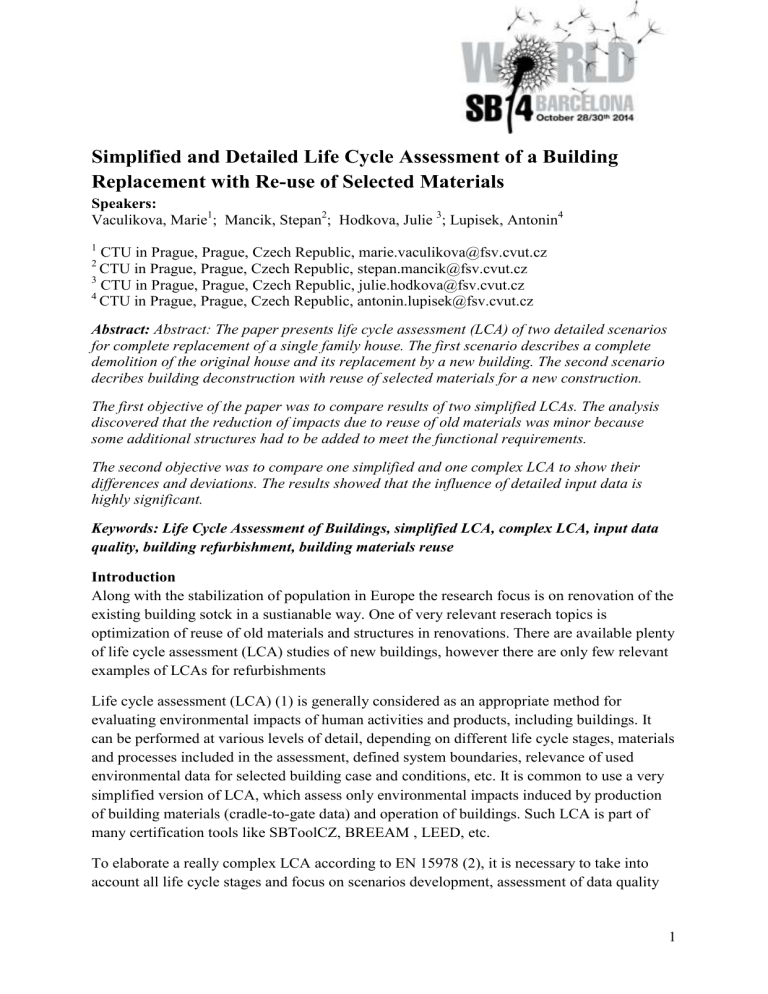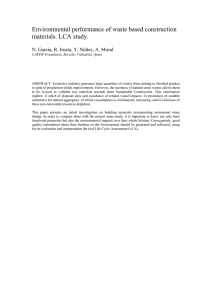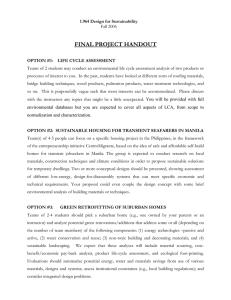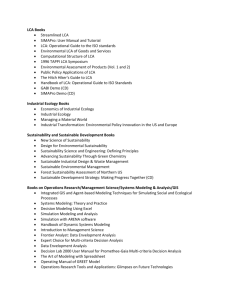Simplified and Detailed Life Cycle Assessment of a Building

Simplified and Detailed Life Cycle Assessment of a Building
Replacement with Re-use of Selected Materials
Speakers:
Vaculikova, Marie
1
; Mancik, Stepan
2
; Hodkova, Julie
3
; Lupisek, Antonin
4
1
CTU in Prague, Prague, Czech Republic, marie.vaculikova@fsv.cvut.cz
2
CTU in Prague, Prague, Czech Republic, stepan.mancik@fsv.cvut.cz
3
4
CTU in Prague, Prague, Czech Republic, julie.hodkova@fsv.cvut.cz
CTU in Prague, Prague, Czech Republic, antonin.lupisek@fsv.cvut.cz
Abstract: Abstract: The paper presents life cycle assessment (LCA) of two detailed scenarios for complete replacement of a single family house. The first scenario describes a complete demolition of the original house and its replacement by a new building. The second scenario decribes building deconstruction with reuse of selected materials for a new construction.
The first objective of the paper was to compare results of two simplified LCAs. The analysis discovered that the reduction of impacts due to reuse of old materials was minor because some additional structures had to be added to meet the functional requirements.
The second objective was to compare one simplified and one complex LCA to show their differences and deviations. The results showed that the influence of detailed input data is highly significant.
Keywords: Life Cycle Assessment of Buildings, simplified LCA, complex LCA, input data quality, building refurbishment, building materials reuse
Introduction
Along with the stabilization of population in Europe the research focus is on renovation of the existing building sotck in a sustianable way. One of very relevant reserach topics is optimization of reuse of old materials and structures in renovations. There are available plenty of life cycle assessment (LCA) studies of new buildings, however there are only few relevant examples of LCAs for refurbishments
Life cycle assessment (LCA) (1) is generally considered as an appropriate method for evaluating environmental impacts of human activities and products, including buildings. It can be performed at various levels of detail, depending on different life cycle stages, materials and processes included in the assessment, defined system boundaries, relevance of used environmental data for selected building case and conditions, etc. It is common to use a very simplified version of LCA, which assess only environmental impacts induced by production of building materials (cradle-to-gate data) and operation of buildings. Such LCA is part of many certification tools like SBToolCZ, BREEAM , LEED, etc.
To elaborate a really complex LCA according to EN 15978 (2), it is necessary to take into account all life cycle stages and focus on scenarios development, assessment of data quality
1
and its representativeness (3). Such approach is very time-consuming and requires a large amount of data that is difficult to get or not available at all.
Nowadays, a strong emphasis is put on reducing energy efficiency of buildings as well as the utilization of renewable, recycled or reused materials. Therefore, significance of the environmental impact of life cycle stages such as the transport of materials, construction, maintenance and end of life of the building in relation to the overall impact is increasing.
Another area of concern is the assessment of refurbishments of existing buildings and their impacts compared to new construction. This paper aims to fill the gap in such assessments and provide LCA calculations of building renovation in two detailed life cycle scenarios. First objective of the work was to compare two simplified LCAs of a building, according to two pre-defined scenarios (see Methods), to show the influence of reuse of old materials on the environmental profile of building. Second objective was to compare one simplified and one detailed LCA of the same building to show differences and deviations of results. The version of building with reused materials was considered for this case.
Methods
Basic methodology
For the simplified LCAs the methodology of SBToolCZ (4) was followed and Envimat database was used (5) as a source of data on buidling materials. For the detailed LCA modelling, EN 15978 Sustainability of construction works – Assessment of environmental performance of buildings (2) was followed and SimaPro (6) software was used.
Specification of the object of assessment
The object of assessment was specified as follows:
Functional equivalent: family house for 4 persons, low-energy requirements;
Reference study period: 60 years;
System boundary: Cradle to grave (modules A1-C4) , boundaries specific to individual modules and building elements were defined separately for each particular case;
The building model – including the quantification of mass and energy flows and description of the physical characteristics of the building.
Scenarios
The two detailed scenarios of the whole life cycle of the building were modelled as a basis for all calculations. Both scenarios fulfilled the same layout and quality of the envelope strucutres of the building:
1) Demolition of the original house and its replacement by completely new building with using new materials;
2) New building reusing some of the materials from demolition of the original building.
The reuse included use of existing foundations and full burned bricks for new walls
(14 tons of bricks reused, which was about 10% of total building mass).
2
Scenarios were modelled for all building parts and were divided in life cycle modules according to EN 15978: A1-A5, B1-B5, B6-B7, C1-C4. Module D was excluded but will be part of the future work.
Simplified calculation model
The simplified LCA models included only the main building elements according to available bill of quantities and used only cradle to gate data for materials and service lives pre-defined by SBToolCZ. Regarding the operation stage, the energy consumption of buildings and related emissions were included. The designed quality of the building envelopes and resulting energy consumtion for both scenarios were also considered.
SimaPro calculation model description
The complex LCA model was created in SimaPro software, which uses Ecoinvent database, it means generi environmantal data. Detailed LCA requires specific environmental data, but such a data are not available in Czech conditions. The building was divided into individual building parts according to Czech national building practice and according to this special case
(p.e. ceiling and partitions are in one group, because the same systeme is used for both), see
Figure 2.
Building
Figure 2 Building parts defined for the complex LCA model
Scenarios were defined for each building part and modules A-C. They were modeled in
SimaPro as individual life cycles (LC), e.g. LC of Frame. According to (2), when performing
LCA, all modules from A1 to C4 should be considered. Some LC stages were re-grouped:
Module A was composed of parts A1-A3 (cradle-to-gate) and parts A4-A5 (transport and construction phases);
Module B was composed of parts B1-B5 and parts B6-B7;
Module C was considered as one single module including parts C1-C4, which were all modeled (if relevant for the building part), but finally they were assessed as one single module.
Module D was not part of the model. It means that benefits from recycling or reuse were not taken into account. Materials and structures, which go to recycling or reuse, left the system when they have a positive economic value (2).
3
All these individual life cycles were combined into one complete life cycle, adding also the operational stage of the building (modules B6 and B7). An example of the individual LC model is shown in Figure 3.
Figure 3 Example of the structure of complex LC model for foundations elaborated in SimaPro (8)
Results
1. Comparison of simplified LCAs for completely new building and building with reused
Results in Figure 4 show, that according to the simplified LCA, the reuse of existing materials and structures has no positive effect on the environmental impact of the building – the reduction of considered impacts is in most of the cases negative.
Figure 4 Total value of environmental indicators for both scenarios and simplified LCAs of the building, showing the percentage of indicator reduction due to reuse of materials
4
Figure 5 illustrates the impacts of individual building parts on the complete building LC. In scenario 2, the reused materials (e.g. bricks) are considered as to have no environmental impact. But new bricks, used in scenario 1, have quiet small impact regarding the use of non renewable primary energy.
Scenario 1 completely new building others
2% woodbased slabs
2% floors
3% bricks
7% plastics
8% metals
25% windows
7% wood
8% insulation s
32% silicate materials
6% woodbased slabs
5% floors
3% bricks
0% windows
7% wood
8%
Scenario 2
Building with reused materials plastics
8% others
2% metals
28% insulations
33% silicate materials
6%
Figure 5 The distribution of non-renewable primary energy use between different materials
2. Comparison of simplified and complex LCA of one building scenario
Complex LCA was performed for every building part. Figure 6 shows example of results for three most important building parts – foundations, load bearing frame and insulation of walls), and two indicators (global warning potential and acidification potential). It is obvious that for all parts and both indicators the values resulting from complex LCA are much higher.
It is due to the fact, that simplified LCA includes only modules A1-A3 (cradle to gate data) and modul B4 (replacement).
Global Warming Potential [kg CO
2
,eq] Acidification Potential [kg SO
2
,eq]
14000
12000
10000
8000
6000
4000
2000
Simplified LCA
Detailed LCA
50
45
40
35
30
25
20
15
10
5
Simplified LCA
Detailed LCA
0 0
Foundation Frame Insulation of Foundation Load bearing Insulation of walls + facade frame walls + facade
Figure 6 Comparison of several results of simplified and complex LCA for three important building parts
Figure 6 Comparison of several results of simplified and complex LCA for three important building parts
5
By performing complex LCA it was proved that life cycle stages, which are not included in simplified LCA have significant influence on environmental impact of building within its whole life cycle. Figure 7 shows the contribution of different life cycle stages on global warming potential of three buildings parts. Apparently, the production stage (A1-A3) has the biggest influence, but the use stage (mainly B3-B4) and end-of-life stage (C1-4) is also quite important.
14000
Global Warming Potential of Individual Life Cycle Stages of Selected Building Parts
12000
10000
8000
6000
4000
A1-A3 Production stage
A4-A5 Construction stage
B3-B4 Replacement and repair
2000
C End-of-life stage
0
Foundations Frame Insulation of walls + facade
Figure 7 Influence of individual life cycle stages on total life cycle impact (GWP) of several building parts
Discussion
The main critical issues disclosed by the work emerged during the modeling of complex LCA and include the following:
It is not possible to meet the requirements for the quality and relevance of data recommended by EN 15978, as there are almost no EPDs available in Czech Republic.
Generic data must be used instead.
Scenarios are often based on assumptions, regarding e.g. maintenance or renovation processes.
The end of the life stage should be, as recommended, modelled using scenarios considering the currently used technology situation. However, the developement in the waste management field can be a very significant factor that we have not taken into account. For example plastic windows are used only since the nineties and the vast majority of them still works. Even if the PVC is easily recyclable material, there is so little plastic windows waste that no recyclation can be considered yet.
It is often not possible to get sufficient information about individual materials and elements and connected processes (e.g. transport distances, transport vehicle, amount of construction waste, etc.)
6
Conclusion
The simplified LCA results showed that the impacts of material reuse can be marginal. This finding was unexpected and thus very important for future work, where more case studies should be done in this field, comparing also the third scenario – complete refurbishement of old building without its demolition.
On the other hand, the comparison of simplified and complex LCA of one building scenario pointed out the importance of scenarios developement, included life cycle stages, which are usually neglected, and amount of data sets that are needed to get good quality results.
Nevertheless, further research in the field of comaparisons of complex and simplified LCAs and building refurbishements against new constudtions is needed to confirm the results to be a rule.
Aknowledgement
This work was supported by the Grant Agency of the Czech Technical University in Prague, grant No. SGS13/107/OHK1/2T/11 and by the European Union, OP RDI project No.
CZ.1.05/2.1.00/03.0091 – University Centre for Energy Efficient Buildings.
References
1. Guinée, J.B., et al. (2002), Handbook on life cycle assessment. Operational guide to the
ISO standards. I: LCA in perspective. IIa: Guide. IIb: Operational annex. III: Scientific background. Dordrecht : Kluwer Academic Publishers, 2002. p. 692. ISBN 1-4020-0228-9.
2. EN 15978 Sustainability of construction works – Assessment of environmental performance of buildings – Calculation method.
3. Hodková, Julie and Lasvaux, Sebastien (2012), Guidelines for the Use of Existing Life
Cycle Assessment Data on Building Materials as Generic Data for a National Context. LCA and Construction 2012, Proceedings of the International Symposium on Life Cycle
Assessment and Construction , pp. 265-273. ISBN 978-2-35158-127-8.
4. Vonka, Martin & kolektiv (2010), Metodika SBToolCZ - Manuál hodnocení bytových staveb ve fázi návrhu.
Praha : CIDEAS, Fakulta stavební ČVUT v Praze, 978-80-01-04664-7.
5. Hodková, Julie, et al. (2011), Envimat.cz - Online database of environmental profiles of building materials and structures. IFIP Advances in Information and Communication
Technology , 359, pp. 272-279. ISSN 1868-4238.
6. PRÉ. SimaPro. [Online] PRé sustainability. [Citace: 1. 11 2012.] http://www.presustainability.com/simapro-lca-software.
7




